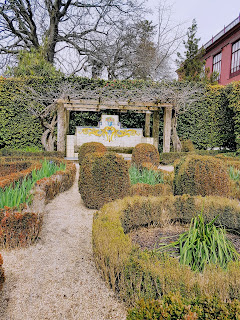Photos 15th March 2018 (Thursday).
Porto
Thursday morning at the hostel during breakfast... Take That on TV!
Enjoying a calm stroll through the city...
In the background of the photo there is the Arrábida Bridge... A superb piece of ingineering and one of my fav bridges of the city. Nowadays you can climb the arch of the Arrabida bridge from the inside
Watching the river in a climate of genuine relaxation
The Faculty of Arts and Humanities of the University of Porto (FLUP)
Madureira's Restaurant
Campo Alegre Street (Rua do Campo Alegre)
FCUP Department of Computer Sciences.
Ciência de Computadores da Faculdade de Ciências da Universidade do Porto
Casa de Allen or Palacete Villar d'Allen, Antonio Cardoso Street (Rua de António Cardoso 175). António Cardoso Street, located in a very residential area of the city, is a beautiful street that connects the main Boavista Avenue with the Botanical Gardens. It's named after a poet, like many of the streets in this neighborhood!
In this street, you can find the great Casa d’Allen, a mansion built in 1920 by the 3th Viscount of Villar d’Allen to be his residence. The house was designed by the famous architect Marques da Silva and it was built in a time where a lot of mansions were being erected, giving Porto a true bourgeois look! Nowadays the mansion work a cultural space, with library and archives, in the responsibility of the state... At António Cardoso Street you'll find also the Botanical Gardens :)
Prestigious residential area, between Av. Da Boavista and Campo Alegre, has the Botanical Garden and Casa das Artes in the immediate vicinity and the most diverse services and commerce essential to daily life (Rua de Manuel Bandeira, Rua da Venezuela, etc.)
Clínica Luso Espanhola is one of the most prestigious aesthetic clinics in Portugal
200 Rua da Venezuela
245 Rua da Venezuela
Casa das Artes (House of Arts)↓
Designed by Eduardo Souto Moura in 1980, the building of the Casa das Artes (House of Arts) in Porto is one of the architect's most emblematic works. The project was selected within the framework of a public tender for construction of a cultural facility in the gardens of a manor house that had been built in 1927.
The solution presented by Souto Moura made use of a wall existing on one of the gardens boundaries, thus constructing a “wall-building” that demarcates the boundaries of the terrain and is perfectly integrated within the environment. This integration was also achieved by means of the materials used in the exterior covering of the building such as brick, stone and mirrored glass that create an illusionary effect of extension of the garden.
The interior has one basement floor and houses two auditoriums within an amphitheatre that is used for performances, conferences and exhibitions
Porto’s Botanical Garden (Portuguese: Jardim Botânico do Porto) is a space where three dimensions converge: recreation, history and botanics. It's not a very big garden – 4 ha to be precise – but it's full of old town charm. It's located in the gardens of the Campo Alegre Estate or Andresen House. The Porto Botanical Garden is managed by the Faculty of Sciences which pertains to the University of Porto...
This beautiful and lush garden stretches along the land of the former Andersen's family house where you can enjoy the groves of naturalist arrangement, a plants’ collection or even hothouses with orchids, carnivorous plants and ferns, among other tropical and subtropical plants...
The Porto Botanical Garden might not be the most spectacular green space in Porto, yet it might just as well be visited by holidaymakers...
The garden was created in 1951 under the patronage of the Portuguese state, on the former manor of Joao Henrique Andresen (acquired by the said Joao Henrique Andresen in 1895, and turned by its owner into a romantic garden). In time, the Porto Botanical Garden was greatly diminished, both in terms of size (now, its surface amounts to some 4 hectares) and plant life patrimony (though the diversity of the flora is quite notable)
However, at present the garden shelters sundry rare and exotic plant species, featuring highlights like the cacti garden, a greenhouse and a historical garden (the latter comprising a rose garden). There’s also a lake situated within the perimeter of the Botanical Garden, the habitat of a fairly numerous population of water lilies.
Camellia trees
For Camellia lovers, you’ll find here a fair number of Camellia Japonica (the most common Camellia), scattered throughout. This is definitely my favorite flower of the entire garden...
This exotic botanical species thrives in Portugal’s mild Atlantic climate, making the city a rich, floral wonderland for almost half the year! From January to March the North of Portugal is completely blanketed in silky multi-colored petals, providing you a wide window to choose from. If you’re planning a spring trip, fabulous! As a result of climate change, Camellias are prolonging their stay in many parts of the North, giving you an extra opportunity to savor their beauty...
The Oporto Botanical Garden used to be the grandparents house of the famous portuguese short story writer Sophia de Mello Breyner Andresen and of her cousin Ruben A., also a famous novel writer
While the historical garden is beautiful, the most charming areas are around the greenhouses. Though they look a bit neglected, it makes them even more fascinating. Plants wind through metal frames that once held glass...
Jardim dos Jotas or the J Letter Garden: This garden takes its name from the initials of the former owners of Quinta do Campo Alegre, João Henrique and Joana Andresen, who were the grandparents of the writers Sophia de Mello Breyner Andresen and Ruben A. Four boxes are planted in the shape of the letter "J", taking up the entire space.
This garden was always a favourite place for planting bulbs. The tilled-covered bench shaded by a wisteria-pergola is often mentioned in Sophia's works
A magnificent red house surrounded by lush greenery. Built in the early 1900s, the Andresen house is located in a neat and tidy part of the gardens called the “historical garden.” This area is divided into three distinct sections: the Rose Garden, the J Letter Garden, and the Fish Garden, where you can find a graceful pond filled with water lilies
Magnificent panoramic views from the Arrábida Bridge
Collages
Photos 16th March 2018 (Friday). Porto
This day I decided to go to see the sea with two German friends I met at the hostel (Michelle and Karine). I really liked everything I was seeing... One of the best thing to do in Porto is either to walk (go by tram or bike) between Ribeira and Foz, going along the river Douro till the sea

I would still recommend you go to Porto's Atlantic Ocean seafront
and enjoy a promenade along the sea-front. There is lots to see...





























































































































































































































.jpg)


No comments:
Post a Comment